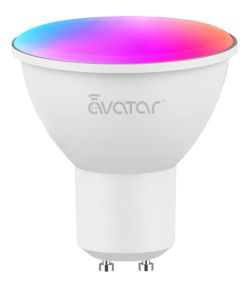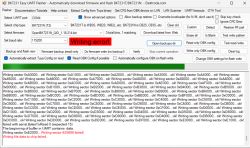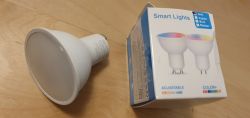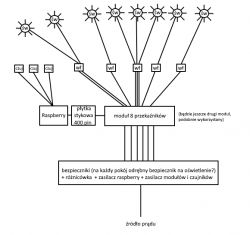Hello practitioners and smart home/residential professionals and anyone else interested in this thread 
Please evaluate the smart home idea, suggestions on what to give up, what to change, what to necessarily do, also through the prism of how they are implemented colloquially I am also very interested in how it should look like in the switchboard, please give me some hints.
I am also very interested in how it should look like in the switchboard, please give me some hints.
The project is amateurish and was created while gaining knowledge "on the fly", it's hard not to use bare concrete - general from a renovation in the flat
The Raspberry Pi 3B+ with Home Assistant (so far I've really liked this kit) will be the heart of the whole thing.
I am very much counting on your help !
The aim is to control the lighting - the cables are drawn directly to the switches, there are almost 16 wires in total, which will be controlled in 8 rooms/places - with relay modules. In addition, collecting temperature and humidity from selected rooms from sensors, collecting and using information from reed switches, e.g. entrance doors, PIR sensors, and later probably reed switches on wifi for other doors and control of additional lighting, such as LED strips or plafonds via RF, but I have to read both. I would also like to find out how to log a doorbell press (?) and possibly use this to trigger the recording of a short video from the judas - I have found some information on the latter.
Everything will be mounted on a DIN rail in a 3x18 switchboard (with room for ideas) :
Raspberry 3B+ with 3x3cm fan and power supply,
400 pin contact board for the modules and sensors,2 modules of 8 relays with probably a separate power supply for them and for the sensors,
Temperature sensor.
In the switchboard or very close by I am considering putting a LAN switch.
By the prism of the temperature measurements collected I will consider adding a fan.
As far as the wiring is concerned, there is a decent twisted pair cable for the optional sensors and others to each light control box - switches - in addition and e.g.: one day under the light switch status download but here too I need to educate myself....
The solution (perhaps eventually) is to work on the principle: the current is fed from the fuses through the relay module via NC (normally closed) and the control would be based on normal switches plus there would be the option of control when the switch is on - then there would be the additional possibility of controlling the application on the phone via Home Assistant or by other means... Due to the use of NC then the relays would not generate the temperature until the lights are switched off with them and the whole thing would work regardless of what happens to the tinkerer the current would go to the lights traditionally. Water features available for those interested and within the needs.... I am tempted to call this project a hybrid smart home/apartment .
.
Please evaluate the smart home idea, suggestions on what to give up, what to change, what to necessarily do, also through the prism of how they are implemented colloquially
The project is amateurish and was created while gaining knowledge "on the fly", it's hard not to use bare concrete - general from a renovation in the flat
The Raspberry Pi 3B+ with Home Assistant (so far I've really liked this kit) will be the heart of the whole thing.
I am very much counting on your help !
The aim is to control the lighting - the cables are drawn directly to the switches, there are almost 16 wires in total, which will be controlled in 8 rooms/places - with relay modules. In addition, collecting temperature and humidity from selected rooms from sensors, collecting and using information from reed switches, e.g. entrance doors, PIR sensors, and later probably reed switches on wifi for other doors and control of additional lighting, such as LED strips or plafonds via RF, but I have to read both. I would also like to find out how to log a doorbell press (?) and possibly use this to trigger the recording of a short video from the judas - I have found some information on the latter.
Everything will be mounted on a DIN rail in a 3x18 switchboard (with room for ideas) :
Raspberry 3B+ with 3x3cm fan and power supply,
400 pin contact board for the modules and sensors,2 modules of 8 relays with probably a separate power supply for them and for the sensors,
Temperature sensor.
In the switchboard or very close by I am considering putting a LAN switch.
By the prism of the temperature measurements collected I will consider adding a fan.
As far as the wiring is concerned, there is a decent twisted pair cable for the optional sensors and others to each light control box - switches - in addition and e.g.: one day under the light switch status download but here too I need to educate myself....
The solution (perhaps eventually) is to work on the principle: the current is fed from the fuses through the relay module via NC (normally closed) and the control would be based on normal switches plus there would be the option of control when the switch is on - then there would be the additional possibility of controlling the application on the phone via Home Assistant or by other means... Due to the use of NC then the relays would not generate the temperature until the lights are switched off with them and the whole thing would work regardless of what happens to the tinkerer the current would go to the lights traditionally. Water features available for those interested and within the needs.... I am tempted to call this project a hybrid smart home/apartment







